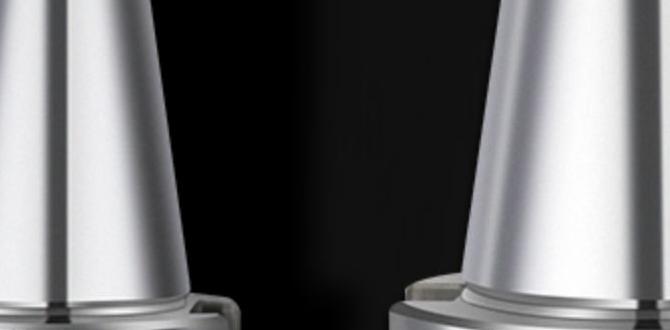Proven Carbide End Mill: Bronze Chip Evacuation Essential
This guide explains why specialized carbide end mills with features for bronze chip evacuation are vital. Learn how the right end mill design prevents clogging, improves cut quality, and extends tool life when machining soft metals like bronze. We’ll guide you to the perfect tool for cleaner, faster machining.
Hey there, fellow makers! Daniel Bates here from Lathe Hub, ready to shine a light on one of those little details that makes a HUGE difference in the workshop: chip evacuation when machining bronze. If you’ve ever struggled with gummy chips clinging to your end mill, making a mess and ruining your finish, you’re not alone. It’s a common challenge, especially with softer metals. But don’t worry, the solution is simpler than you might think! We’re going to dive into how the right carbide end mill can be your best friend for tackling bronze. Stick around, and we’ll get your milling projects running smoother and cleaner than ever before.
Why Bronze Chip Evacuation is a Big Deal
Machining bronze can be a rewarding experience, opening up possibilities for beautiful and functional parts. However, bronze, like many non-ferrous metals, has a tendency to be ‘gummy.’ This means the chips produced during cutting don’t break away cleanly. Instead, they can cling to the cutting edges of your end mill, leading to a host of problems. This phenomenon is often referred to as “birdnesting” or simply “chip packing.”
When chips pack into the flutes of your end mill, they can:
- Increase cutting forces, leading to tool deflection and inaccurate dimensions.
- Generate excessive heat, which can prematurely wear out your carbide end mill.
- Cause poor surface finish on your workpiece as re-cut chips drag across the material.
- Lead to tool breakage if the packing becomes too severe.
- Significantly slow down your machining process as you constantly stop to clear jams.
This is why selecting an end mill specifically designed for effective chip evacuation, especially for materials like bronze, is not just a suggestion – it’s essential for efficient and successful machining. Today, we’re focusing on the proven solutions that make bronze machining a breeze.
Understanding Carbide End Mill Basics
Before we delve into the specifics of bronze machining, let’s quickly cover what a carbide end mill is and why it’s a popular choice. Carbide, or tungsten carbide, is an extremely hard and brittle ceramic-metal composite. This hardness makes carbide end mills exceptionally good at cutting harder materials and maintaining sharp edges at higher speeds compared to high-speed steel (HSS) tools. However, its brittleness means it can chip or fracture if subjected to sudden shock or excessive force.
Key components of an end mill include:
- Shank: The part of the tool that is held by the spindle or collet. Common sizes include 1/4 inch, 3/8 inch, 1/2 inch, and metric sizes like 6mm, 8mm, and 12mm. We’re often looking for tools with a specific shank diameter, like a carbide end mill 3/16 inch 8mm shank, depending on the holder availability.
- Flutes: The helical grooves that run along the cutting portion of the tool. They serve multiple purposes: they create the cutting edges, help evacuate chips from the cutting zone, and can influence the tool’s strength and chip control.
- Cutting Edges: The sharp points on the periphery and end of the flutes that do the actual material removal.
- End Cut (Face Mill): The tip of the end mill. Some end mills have a flat end, while others have a ball nose, radius, or corner chamfer.
The geometry of these components, particularly the flutes, is what dictates how well an end mill performs in different materials and applications. For bronze, we need flutes that help push those sticky chips away.
The Crucial Role of Flute Design for Bronze
This is where the magic happens for machining bronze. The standard flute designs found on general-purpose end mills often aren’t ideal for softer, gummier metals. For effective bronze chip evacuation, we look for specific flute characteristics:
1. Increased Helix Angle
The helix angle is the steepness of the spiral flute.
- Standard Coarse Pitch (low helix): These have fewer flutes per inch and are good for general-purpose milling and materials that produce short chips.
- High Helix Angle: End mills designed for bronze often feature a higher helix angle (e.g., 45-60 degrees). This steeper spiral acts like a screw conveyor, more aggressively pulling chips away from the cutting zone and up and out of the workpiece. The increased angle also leads to a more shearing cut action, which can help break chips into smaller, more manageable pieces.
2. Polished or Bright Flutes
This is perhaps the most critical feature for bronze. Standard end mills might have a rougher, coated, or even black oxide finish in their flutes. These surfaces can be slightly porous or have microscopic irregularities that provide a “sticking point” for gummy chips.
- Polished Flutes: End mills designed for bronze, and other non-ferrous materials, typically have highly polished or “bright” flutes. This mirror-like finish significantly reduces friction and prevents chips from adhering to the flute walls. Think of it like trying to stick wet dough to a greased pan versus a dry one – the polished surface lets things slide right off.
- Special Coatings: While not always used for bronze, some coatings can enhance lubricity. However, for bronze, the polished flute itself often provides the necessary non-stick surface.
When searching for the right tool, look for terms like “polished flute” or “bright finish” in the product description. For example, a “carbide end mill 3/16 inch 8mm shank standard length for bronze chip evacuation” is likely to specify these features.
3. Fewer Flutes
While not a strict rule, end mills with fewer flutes (e.g., 2 or 3 flutes) are often preferred for softer metals like aluminum and bronze.
- More Chip Room: With fewer flutes, the space between them (the flute gullet) is larger. This increased volume provides more space for chips to accumulate and be carried away without packing.
- Reduced Heat: Fewer flutes mean less friction and heat generation during cutting, which is beneficial for softer metals that can soften and gum up at elevated temperatures.
Though 4-flute end mills are excellent for chatter resistance and finishing in steels, the chip packing issue can be more pronounced in bronze. A 2-flute design, especially with high helix and polished flutes, is often the go-to. An 8mm shank is a very common size that offers good rigidity for many workshop machines.
4. Effective End Cut Geometry
The design of the tip of the end mill also plays a role. While not as critical as flute polish for evacuation, certain geometries can aid in chip flow.
- Eccentric Relief: This subtle feature on the cutting edges can help maintain tool sharpness and reduce cutting forces.
- Chip Breakers: Some specialized end mills incorporate small notches on the cutting edge to deliberately break chips into smaller pieces. This is less common for standard bronze-evacuation tools but can be beneficial in specific situations.
Choosing the Right Carbide End Mill for Bronze: A Step-by-Step Guide
Now that we understand the “why,” let’s get to the “how” of selecting the perfect end mill for your bronze projects.
Step 1: Identify Your Material
Confirm you are indeed working with bronze. Different alloys of bronze can have slightly different machining characteristics, but the general principles for chip evacuation remain the same. Most common engineering bronzes, like phosphor bronze or bearing bronze, will benefit from specialized tools.
Step 2: Determine Your Machining Operation
- Roughing: If you’re removing a lot of material quickly, you’ll want an end mill optimized for high material removal rates. This might mean a lower flute count and aggressive geometry.
- Finishing: For smooth surface finishes, you’ll want an end mill designed for precision and less vibration. A slightly higher flute count (if chip evacuation is still managed) or a more precisely ground edge might be preferred, but polished flutes are still paramount.
- Slotting or Pocketing: These operations are where chip evacuation is most critical, as chips have less room to escape.
Step 3: Specify Key End Mill Features
When you’re looking at product listings or talking to a tool supplier, keep these in mind:
- Material: Solid Carbide (essential for most modern machining).
- Coating: Uncoated (often best for bronze, as coatings can sometimes add a surface for chips to stick to unless specifically designed for non-ferrous).
- Flute Count: 2 or 3 flutes are generally preferred.
- Helix Angle: High helix (45-60 degrees is common).
- Flute Finish: Polished or Bright Flutes (ABSOLUTELY ESSENTIAL).
- Shank Diameter: This needs to match your collet or tool holder. A carbide end mill 8mm shank is a very common size for many benchtop milling machines and smaller industrial machines. A 3/16 inch shank is also common in smaller hobbyist machines. Ensure your tool holder can accept the shank size precisely.
- End Type: Flat end, ball nose, or corner radius, depending on your desired cut. For general milling and pocketing, a flat end is typical.
- Length: Standard length is usually sufficient unless you need to reach deep into a cavity.
Step 4: Consult Manufacturer Resources
Reputable tool manufacturers, such as Sandvik Coromant, Kennametal, or Harvey Tool, will often have specific product lines dedicated to non-ferrous metals. Their websites are excellent resources for finding tools with the right specifications. Look for sections on “Non-Ferrous” or “Aluminum/Copper Alloys” when browsing their catalogs.
Step 5: Don’t Forget Cutting Parameters
Even with the perfect end mill, incorrect cutting speeds and feeds can still cause chip packing. For bronze:
- Feed Rate: Generally, a higher feed rate that allows for a decent chip load (the thickness of material removed by each cutting edge per revolution) is beneficial. This helps push chips out.
- Spindle Speed: Start with recommended speeds for carbide on bronze and adjust based on chip formation. You want to see small, well-formed chips, not long, stringy ones.
- Lubrication: Using a cutting fluid or mist coolant is highly recommended. This not only cools the cutting edge but also lubricates the chip, helping it flow more freely out of the flutes. Compressed air can also be effective for chip blowing.
Example Tool Specification: “Carbide End Mill 3/16 Inch 8mm Shank Standard Length for Bronze Chip Evacuation”
Let’s break down what this search query implies and what you’d expect features-wise:
Carbide End Mill:
Confirms the material of the tool itself, offering hardness and heat resistance.
3/16 Inch 8mm Shank:
This is an interesting combination sometimes seen in listings. Often, a tool will have either a imperial shank size (like 3/16″, 1/4″, 1/2″) or a metric shank size (like 6mm, 8mm, 12mm). It’s possible this refers to a tool that might have an 8mm shank with specific adapter sleeves to fit it perfectly into a 3/16″ holder, or it’s a conflation of common sizes. In practice, you usually select one or the other to match your machine’s tooling. The 8mm shank is very standard for many hobbyist/benchtop mills. Ensure you know your machine’s collet or holder size!
Standard Length:
Means it’s not an extended reach or stubby tool. This is suitable for general machining tasks.
For Bronze Chip Evacuation:
This is the key functional requirement. It tells you the manufacturer has designed this tool specifically for this purpose. You should expect:
- Polished/Bright Flutes: This is non-negotiable for excellent chip evacuation in bronze.
- High Helix Angle: Likely 45-60 degrees for effective chip conveying.
- 2 or 3 Flutes: To maximize chip room.
When purchasing, always double-check the detailed specifications from the manufacturer to ensure it meets all these criteria. Don’t just rely on the product title alone.
When to Use Specialized End Mills vs. General Purpose
It’s a question many beginners ponder: can I use my standard end mills, or do I really need a special tool?
General Purpose End Mills
These are typically 4-flute, often with a bright or black oxide finish, and a standard helix angle. They are workhorses for materials like mild steel, stainless steel (with appropriate parameters), and some plastics. They offer good balance between rigidity, surface finish, and chip removal in these materials.
Specialized End Mills (for Bronze)
Characterized by polished/bright flutes, high helix angles, and often 2 or 3 flutes. These are optimized for materials that produce long, stringy, or gummy chips. They excel in:
- Non-ferrous metals: Aluminum alloys, copper, brass, and indeed, bronze.
- Plastics: Some softer plastics that are prone to melting and gumming up.
The Verdict: While you might be able to machine bronze using a general-purpose end mill with extreme caution, meticulous coolant application, and very shallow depth of cuts, it’s an uphill battle. You’ll likely experience more tool wear, poor finishes, and a much higher risk of catastrophic tool failure. Investing in a dedicated bronze-busting end mill will save you time, frustration, and money in the long run. For reliable and efficient results, the specialized tool is the proven path.
Other Considerations for Machining Bronze
Beyond the end mill itself, a few other factors contribute to successful bronze machining:
Coolant and Lubrication
As mentioned, a good coolant or cutting fluid is your best ally. It:
- Cools the cutting zone, preventing the bronze from softening and becoming gummier.
- Lubricates the cutting edge and the chips, allowing them to flow more easily away from the tool.
- Helps wash chips away from the workpiece and tool.
For hobbyist machines, a spray mist coolant system or a simple flood coolant system with a soluble oil designed for aluminum and copper alloys is excellent. Alternatively, a high-quality cutting paste or a dedicated aluminum/bronze cutting fluid applied manually can help. For safety and environmental considerations, always follow manufacturer guidelines for coolants. Organizations like the Occupational Safety and Health Administration (OSHA) provide guidance on safe chemical handling in the workplace.
Machine Rigidity
Bronze can be dense. Ensure your milling machine is rigid and free from excessive play in the axes. A wobbly machine will amplify any issues caused by chip packing, leading to vibration and poor surface finish.
Tool Holding
A high-quality collet system that holds the shank of your end mill securely is vital. Runout (wobble) in your tool holder can exacerbate chip packing and lead to premature tool wear. For an 8mm shank end mill, ensure you are using an 8mm collet or an appropriate collet reducer that is within its specified runout tolerance.
FAQ: Your Beginner Bronze Machining Questions Answered
Q1: What’s the biggest problem when milling bronze?
A1: The biggest challenge is “chip packing.” Bronze is a soft, gummy metal that produces long, stringy chips that tend to stick to the flutes of standard end mills, causing tool wear, poor finish, and potential tool breakage.
Q2: How can I tell if an end mill is good for bronze?
A2: Look for “solid carbide,” “polished flutes” or “bright finish,” and often “high helix” (45-60 degrees). An end mill designed for aluminum is usually also excellent for bronze





